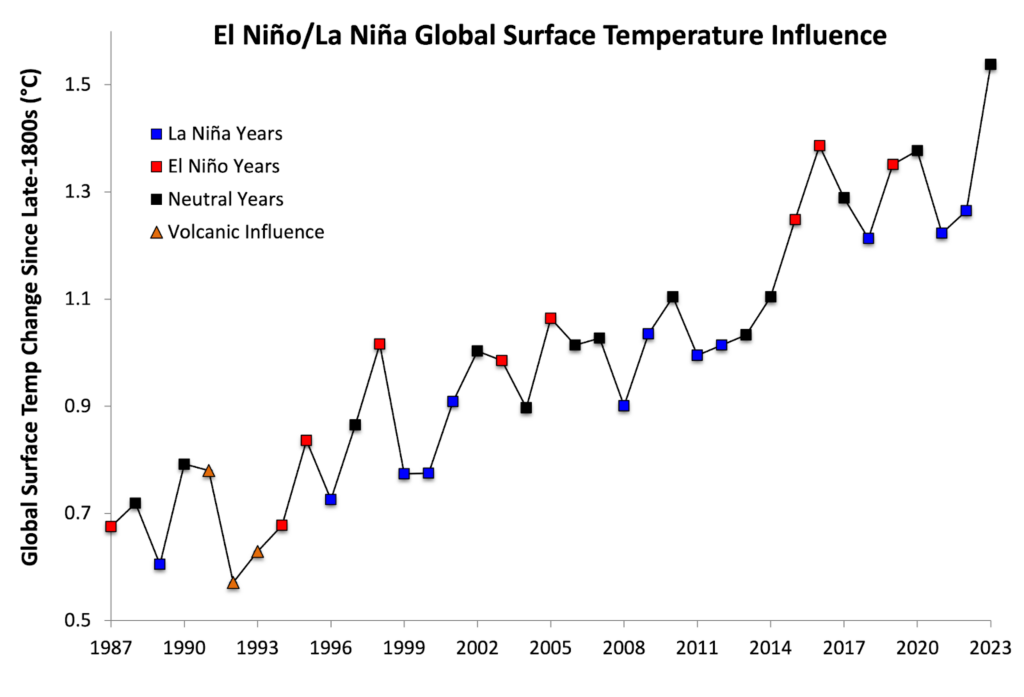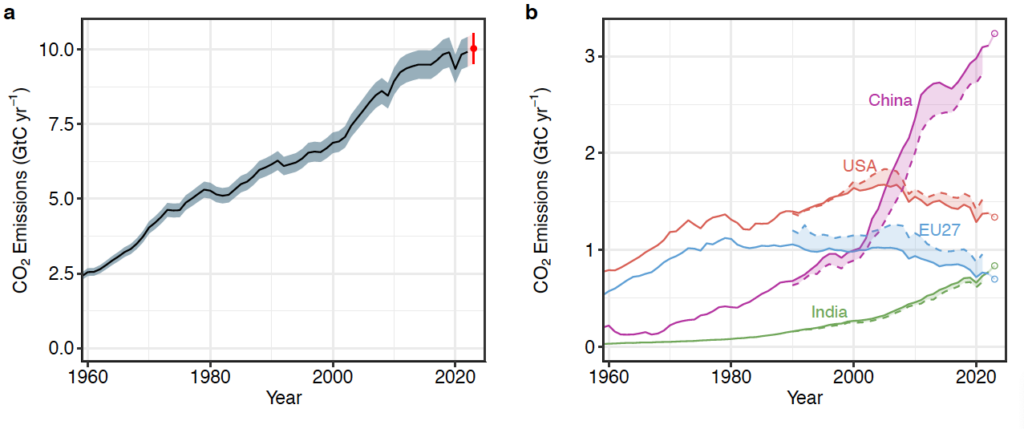5 Mins Read
The world made major progress on climate change in 2023. Here’s what could come next.
By Dana Nuccitelli
The past year broke a plethora of climate and energy records — some bad, but some good.
The year 2023 easily became the hottest year on record. Although climate scientists can’t yet explain precisely why the year was so hot, long-term human-caused global warming and natural variability both played roles in breaking the record. And the past nine years have been the nine hottest on record.

Climate-warming pollution from human fossil-fuel combustion also set a record in 2023, pushing levels of heat-trapping carbon dioxide up to an annual average of nearly 420 parts per million in the atmosphere. A new study published in December 2023 estimated that carbon dioxide levels have not been this high since about 14 million years ago. And a new National Climate Assessment documented how the resulting climate changes are affecting every region of the United States, reporting that the country’s emissions are declining, but too slowly.
Despite all that bad news, many countries are making progress toward reducing their climate pollution, and the outlook for 2024 is encouraging. In fact, 2023 may turn out to be the year in which global heat-trapping pollution peaked and began to decline.
The progress made on climate change in 2023
Democrats in 2022 passed the Inflation Reduction Act, which is designed to give a massive boost to clean technology like solar panels, heat pumps, induction stoves, and electric vehicles.
Although the clean technology investments were only starting to be deployed in 2023, U.S. climate pollution fell by about 2-3% compared to the previous year and is now 18-19% below 2005 levels. Climate pollution in the European Union improved even more, declining by about 6-7% in 2023 as the member nations accelerated their clean energy deployments — in part to reduce their reliance on fossil fuels sourced from Russia.
Those reductions were offset by emissions increases in China and India. Much of China’s rise in climate pollution this year can be attributed to the rebound associated with the end of its “zero-COVID-19” policy in January 2023.

But many clean technologies have also seen record growth in 2023, especially in China. Solar panel deployments broke the previous record set last year by over 50%, with more than half the worldwide total installed in China. Wind turbine, heat pump, and electric vehicle sales likewise set records globally in 2023.
And this clean technology progress is expected to continue accelerating in 2024 and beyond. At the latest international climate meeting in December 2023, 118 governments — 60% of all countries — pledged to triple global renewable energy capacity by 2030. Several key countries joined the Global Methane Pledge, in which 155 governments (80% of all countries) have agreed to cut methane emissions — which heat the atmosphere enormously in the short term — at least 30% by 2030. And for the first time, all countries agreed to transition away from fossil fuels.
The climate change outlook for 2024
Experts believe that if China continues its torrid pace of deploying solar panels and wind turbines, the country could begin to displace its fossil fuel consumption and start a structural decline in carbon pollution in 2024. Much of the rest of the world reduced emissions in 2023, so if China can follow suit in 2024 and the following years, it’s possible that 2023 will become the year in which global climate pollution peaked.
In the United States, the financial incentives passed in the Inflation Reduction Act should continue to accelerate the deployment of clean technologies, and so the country’s climate pollution should continue to decline. State energy offices will begin to roll out the law’s upfront rebates for homeowners to electrify and make their homes more energy efficient toward the middle of 2024. The Inflation Reduction Act’s tax credits for new and used electric vehicles are transferrable to car dealerships as of January 2024, meaning that they will effectively become upfront discounts subtracted from vehicle sticker prices.
Congress is to negotiate the renewal of the Farm Bill this year, which is expected to include funding for natural climate solutions. Congressional lawmakers are also expected to continue to negotiate a permitting reform deal to expedite the deployment of energy infrastructure. And of course, the next federal election on November 5 will be critical in determining U.S. climate policies and pollution in the coming years.
If Republicans sweep the November elections and take control of Congress and the White House, we can expect a replay of what happened the last time that scenario came to fruition in 2017. The Trump administration rolled back more than 100 climate and environmental rules, climate policy took a back seat in Congress, and U.S. climate pollution increased until the COVID pandemic hit in late 2019.
If Democrats sweep the elections, we can expect a similar outcome to what happened when that party had full control of government in 2021-2022. Climate policy was treated as a top priority, and the biggest-ever climate bill was signed into law in the form of the Inflation Reduction Act. If the government remains divided after the election, then the current policy environment will likely continue next year, in which leaders of both parties seek to find modest bipartisan climate bills on which they can agree.
Although the ongoing El Niño event could potentially cause 2024 to break the global temperature record once again, this year could mark a turning point for our energy systems, carbon pollution, and Earth’s climate.
This article by Dana Nuccitelli was originally published on Yale Climate Connections. It is republished here as part of the global journalism collaboration Covering Climate Now.



